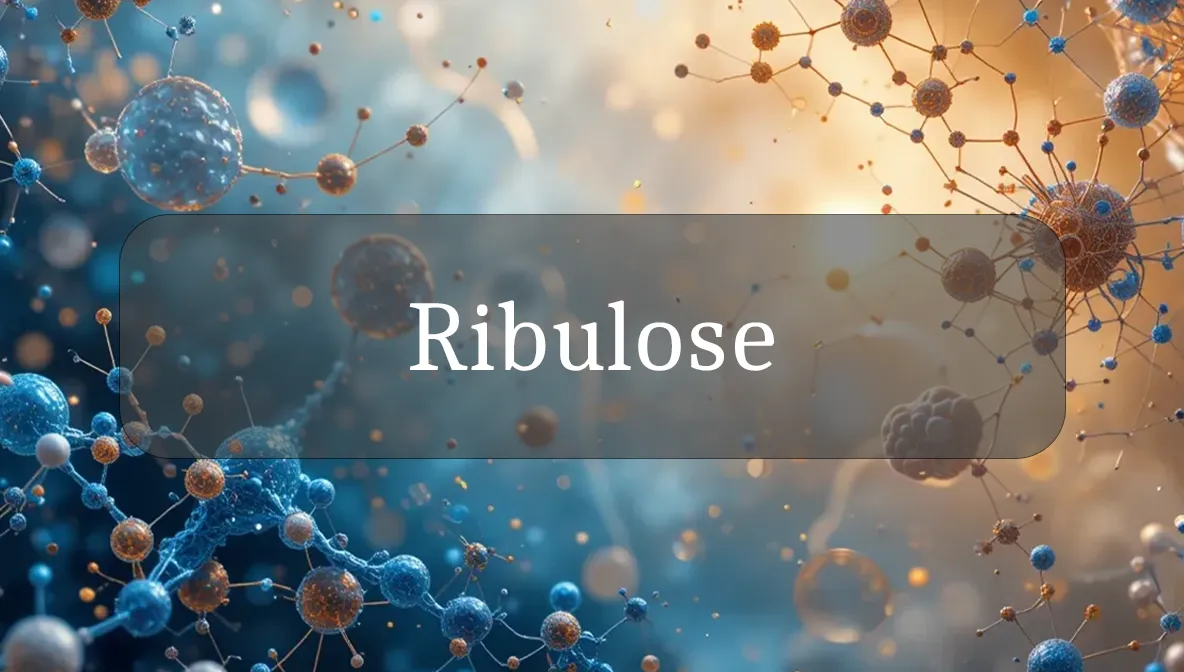Metabolic Sugar for Energy and Biosynthesis
Ribulose is like a backstage worker in your body’s metabolic theater, a five-carbon sugar (pentose) that plays a critical role in energy production and biosynthesis, particularly in the Calvin cycle of photosynthesis and the pentose phosphate pathway in humans. While not a nutrient you consume directly, it’s a key molecule for health-conscious folks interested in how their cells generate energy and building blocks for life. Understanding ribulose can empower you to support your metabolic health. Let’s explore what ribulose is, why it matters, and how you can nurture its function for daily vitality!
Chemical Identity and Type
Ribulose is a monosaccharide (simple sugar) with the chemical formula C₅H₁₀O₅, classified as a ketopentose due to its ketone group and five carbon atoms. It exists primarily as ribulose-5-phosphate (R5P) or ribulose-1,5-bisphosphate (RuBP) in metabolic pathways. In humans, ribulose is an intermediate in the pentose phosphate pathway, produced from glucose-6-phosphate in cells like red blood cells, liver, and adipose tissue. Think of it as a versatile cog in your metabolic machinery, facilitating energy and molecule production.
Biological Role and Benefits
Ribulose, particularly as ribulose-5-phosphate, is vital for cellular metabolism, offering these benefits:
- NADPH Production: In the pentose phosphate pathway, ribulose-5-phosphate helps generate NADPH, a molecule essential for antioxidant defense, fatty acid synthesis, and detoxification in cells.
- Nucleotide Synthesis: It provides ribose-5-phosphate, a precursor for DNA, RNA, and ATP, supporting cell growth, repair, and energy transfer.
- Redox Balance: NADPH from ribulose metabolism protects cells (e.g., red blood cells) from oxidative stress, reducing damage and supporting longevity.
- Metabolic Flexibility: Ribulose intermediates can feed into glycolysis or gluconeogenesis, helping regulate blood sugar and energy supply.
- Erythrocyte Health: In red blood cells, ribulose supports glutathione regeneration, preventing anemia and ensuring oxygen delivery.
Healthy ribulose metabolism keeps your cells energized, protected, and ready for growth, enhancing overall vitality.
Dietary or Natural Sources
Your body produces ribulose internally via the pentose phosphate pathway, starting from glucose, so you don’t get it directly from food. However, you can support its production with these nutrient-rich choices:
- Carbohydrate-Rich Foods: Whole grains (quinoa, oats), fruits (apples, bananas), and vegetables (sweet potatoes) provide glucose, the starting point for ribulose synthesis.
- Vitamin B1 (Thiamine)-Rich Foods: Pork, sunflower seeds, and legumes support enzymes (e.g., transketolase) in the pentose phosphate pathway, aiding ribulose metabolism.
- Magnesium-Rich Foods: Spinach, almonds, and dark chocolate facilitate enzymatic reactions involving ribulose-5-phosphate.
- Antioxidant-Rich Foods: Berries, leafy greens, and nuts reduce oxidative stress, preserving NADPH generated via ribulose for cellular protection.
A balanced diet with complex carbs and micronutrients fuels ribulose production and metabolic health.
Signs of Imbalance or Dysfunction
Impaired ribulose metabolism (often due to enzyme deficiencies or nutrient shortages) may show up as:
- Oxidative Stress: Fatigue, frequent infections, or premature aging from reduced NADPH, impairing antioxidant defenses.
- Anemia: Hemolytic anemia (e.g., in glucose-6-phosphate dehydrogenase deficiency, affecting 400 million people globally) due to insufficient NADPH for red blood cell protection.
- Metabolic Disorders: Poor glucose regulation or low nucleotide synthesis, leading to slow cell repair or growth, especially in rapidly dividing tissues (e.g., skin, gut).
- Neurological Symptoms: Confusion or weakness from thiamine deficiency, disrupting ribulose-related enzyme activity (e.g., Wernicke’s encephalopathy).
- Skin or Mucosal Issues: Slow wound healing or fragile tissues from reduced nucleotide availability for DNA/RNA synthesis.
These symptoms can have many causes, so consult a healthcare provider if they persist to explore metabolic or nutrient-related issues.
Supporting Optimal Levels or Function
To enhance ribulose metabolism and support cellular health, try these evidence-based tips:
- Eat Complex Carbs: Include whole grains, fruits, and vegetables to provide steady glucose for the pentose phosphate pathway, supporting ribulose-5-phosphate production.
- Boost Micronutrients: Consume thiamine-rich (pork, legumes) and magnesium-rich (nuts, greens) foods to optimize enzymes involved in ribulose metabolism.
- Exercise Moderately: Activities like walking or yoga improve glucose uptake, enhancing ribulose production in metabolically active tissues.
- Manage Oxidative Stress: Eat antioxidant-rich foods (berries, green tea) to reduce demand on NADPH, preserving ribulose’s protective role.
- Stay Hydrated: Drink water to support cellular metabolism, ensuring efficient ribulose-related enzyme activity.
Small, consistent habits create a metabolism-friendly environment for ribulose to thrive.
Safety, Interactions, and Precautions
Ribulose is a natural metabolic intermediate and safe when properly regulated, but consider these factors:
- Enzyme Deficiencies: Glucose-6-phosphate dehydrogenase (G6PD) deficiency, common in 5–10% of African, Mediterranean, or Asian populations, impairs ribulose metabolism, causing hemolytic anemia under stress (e.g., drugs like primaquine, infections). Genetic testing can identify risk.
- Nutrient Deficiencies: Low thiamine (e.g., from alcoholism or poor diet) disrupts ribulose-related pathways, leading to metabolic issues. Ensure adequate B1 intake.
- Medications: Drugs like sulfonamides or antimalarials can trigger oxidative stress in G6PD-deficient individuals, affecting ribulose’s protective role. Consult a healthcare provider.
- Chronic Diseases: Diabetes or liver disease may alter pentose phosphate pathway activity, impacting ribulose metabolism. Regular monitoring is key.
Supporting ribulose balance means fueling metabolism and avoiding oxidative triggers.
Fun Fact
Did you know ribulose is a star in plants too? As ribulose-1,5-bisphosphate (RuBP), it’s the molecule that grabs CO₂ in photosynthesis, kicking off the process that makes the oxygen we breathe!
Citations
- National Institutes of Health (NIH): Pentose Phosphate Pathway and NADPH.
- Mayo Clinic: Glucose-6-Phosphate Dehydrogenase Deficiency.
- Cleveland Clinic: Nutrition and Metabolic Health.
- World Health Organization (WHO): Diet and Micronutrient Guidelines.
- USDA: Dietary Guidelines for Americans – Carbohydrate-Rich Diets.

